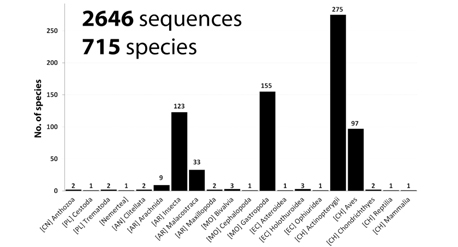VOLUME 7 NUMBER 1 (January to June 2014)

Philipp. Sci. Lett. 2014 7 (1) 104-137
available online: April 23, 2014
*Corresponding author
Email Address: andrewf.torres@yahoo.com
Received: October 11, 2013
Revised: March 14, 2014
Accepted: March 19, 2014
REVIEW
State of animal DNA barcoding in the Philippines: A review of COI sequencing of Philippine native fauna
¹DNA Barcoding Laboratory, Institute of Biology, College of Science,
University of the Philippines, Diliman, Quezon City, Philippines, 1101
²Molecular Ecology and Systematics Laboratory, Institute of Biology, College of
Science,University of the Philippines, Diliman, Quezon City, Philippines, 1101
³Biodiversity Research Laboratory, Institute of Biology, College of Science, University
of the Philippines, Diliman, Quezon City, Philippines, 1101
⁴Natural Sciences Research Institute, College of Science, University of the
Philippines, Diliman, Quezon City, Philippines, 1101
A 648-bp fragment of the cytochrome c oxidase subunit I gene (COI), the gold standard in animal DNA barcoding, is used as a tool in the identification of species as well as the development of proper conservation strategies and management. This paper reviews the current state of DNA barcoding of native fauna in the Philippines through data mining of COI profiles of Philippine specimens in GenBank. Two thousand six hundred forty six sequences, representing 715 species from 216 families and 8 animal phyla, were obtained. This is a miniscule sample considering the megadiversity status of the Philippines, which has a reported species assemblage of more than 50,000 species. Based on the review, two patterns emerged: (1) DNA barcoding of Philippine native fauna focused on insects, gastropods, bony fish, and birds; and (2) nearly 60% of Philippine native species barcoded were generated by laboratories in Canada and the USA. These findings emphasize the need for a more extensive and comprehensive DNA barcoding coverage of Philippine species, commensurate to its megadiversity status, as well as contribute to the representation of Philippine diversity in the global baseline. This can partly be addressed by the active participation of more Philippine institutions and researchers in DNA barcoding efforts.
© 2025 SciEnggJ
Philippine-American Academy of Science and Engineering